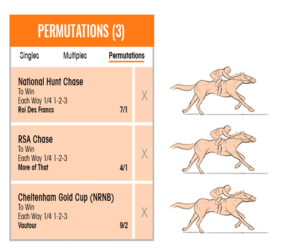What is a ‘Round Robin’ bet?
 Not to be confused with a ‘Round Robin’ tournament, in which each participant plays every other participant, a ‘Round Robin’ bet is a multiple bet, which combines three selections in ten individual bets. Those individual bets are three doubles, one treble and three ‘single-stakes-about’ bets, each of which is actually a pair of bets. The doubles and treble are straightforward enough, but the single-stakes-about bets can be a source of confusion for anyone unfamiliar with ‘any-to-come’ or ‘if-cash’ betting.
Not to be confused with a ‘Round Robin’ tournament, in which each participant plays every other participant, a ‘Round Robin’ bet is a multiple bet, which combines three selections in ten individual bets. Those individual bets are three doubles, one treble and three ‘single-stakes-about’ bets, each of which is actually a pair of bets. The doubles and treble are straightforward enough, but the single-stakes-about bets can be a source of confusion for anyone unfamiliar with ‘any-to-come’ or ‘if-cash’ betting.
For three selections, A, B and C, the ‘any-to-come’ elements of a Round Robin bet are 1-point win A, any-to-come 1-point win B, and vice versa, making two bets, and so on for selections A and C and B and C, making a total of six bets in all. In each pair of single-stakes-about bets, the stake on each selection depends on the success, or failure, of the other selection in the pair. If selection A wins, you effectively double your stake on selection B, while retaining the profit from your winning bet on selection A. If selection A loses, there is nothing to come and the first part of the two-part bet is a loser. Furthermore, even if selection B wins, you still effectively double your stake on selection A, so you lose your entire stake on that pair of bets.